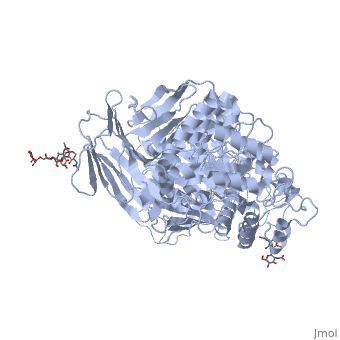Sucrase-isomaltase
From Proteopedia
(Difference between revisions)
| (4 intermediate revisions not shown.) | |||
| Line 1: | Line 1: | ||
| - | < | + | <StructureSection load='3lpo' size='350' side='right' scene='' caption='Human glycosylated sucrase-isomaltase N-terminal domain (PDB code [[3lpo]])'> |
| - | + | ||
== Function == | == Function == | ||
| Line 9: | Line 8: | ||
Some other key enzymes that capitalize on this characteristic in the small intestine are: glucoamylase (Maltase), lactase, and peptidases. Among these common enzymes however is SI, which is important because it is critically involved in the final stage of carbohydrate digestion. <ref> http://www.uniprot.org/uniprot/P14410</ref> Specifically, this enzyme works by catalyzing the conversion of isomaltose into glucose molecules. Cleaving bonds with water (hydrolysis), SI interacts with glucosidic linkages produced by alpha-amylase. <ref>Maureen Barlow Pugh, ed. (2000). Stedman's Medical Dictionary (27th ed.). Baltimore, Maryland, USA: Lippincott Williams & Wilkins. p. 65. ISBN 978-0-683-40007-6. </ref> | Some other key enzymes that capitalize on this characteristic in the small intestine are: glucoamylase (Maltase), lactase, and peptidases. Among these common enzymes however is SI, which is important because it is critically involved in the final stage of carbohydrate digestion. <ref> http://www.uniprot.org/uniprot/P14410</ref> Specifically, this enzyme works by catalyzing the conversion of isomaltose into glucose molecules. Cleaving bonds with water (hydrolysis), SI interacts with glucosidic linkages produced by alpha-amylase. <ref>Maureen Barlow Pugh, ed. (2000). Stedman's Medical Dictionary (27th ed.). Baltimore, Maryland, USA: Lippincott Williams & Wilkins. p. 65. ISBN 978-0-683-40007-6. </ref> | ||
| + | See [[Alpha-glucosidase]] | ||
== Structure == | == Structure == | ||
| Line 45: | Line 45: | ||
-The gene on which SI processes occur is located on chromosome 3 and is composed of 48 exons. | -The gene on which SI processes occur is located on chromosome 3 and is composed of 48 exons. | ||
| - | + | </StructureSection> | |
| - | + | ||
| - | + | ||
| - | + | ||
| - | + | ||
| - | + | ||
== References == | == References == | ||
<references /> | <references /> | ||
| + | [[Category:Topic Page]] | ||
Current revision
| |||||||||||
References
- ↑ http://www.siumed.edu/~dking2/erg/gicells.htm
- ↑ http://www.uniprot.org/uniprot/P14410
- ↑ Maureen Barlow Pugh, ed. (2000). Stedman's Medical Dictionary (27th ed.). Baltimore, Maryland, USA: Lippincott Williams & Wilkins. p. 65. ISBN 978-0-683-40007-6.
- ↑ "SI sucrase-isomaltase (alpha-glucosidase) [Homo sapiens (human)] - Gene - NCBI"
- ↑ Naim HY, Sterchi EE, Lentze MJ (1988). "Biosynthesis of the human sucrase-isomaltase complex. Differential O-glycosylation of the sucrase subunit correlates with its position within the enzyme complex". J. Biol. Chem. 263 (15): 7242–53. PMID 3366777
- ↑ http://www.jbc.org/content/254/6/1821.full.pdf
- ↑ http://onlinelibrary.wiley.com/doi/10.1111/j.1432-1033.1977.tb11335.x/epdf
- ↑ http://www.jbc.org/content/251/11/3250.full.pdf
- ↑ http://www.iffgd.org/site/gi-disorders/other/csid
- ↑ Sim L, Willemsma C, Mohan S, Naim HY, Pinto BM, Rose DR (2010). "Structural basis for substrate selectivity in human maltase-glucoamylase and sucrase-isomaltase N-terminal domains". J. Biol. Chem. 285 (23): 17763–70. doi:10.1074/jbc.M109.078980. PMC 2878540. PMID 20356844

